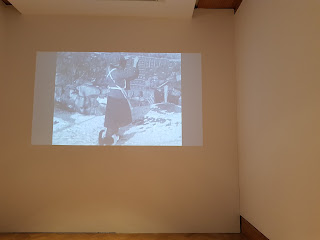Time's winged chariot has been galloping on, as it does. It was quite nice weather for a while
and then it was cold for a week. There was only a wee smattering of snow but it hung around, and the pavements were frosty and thus potentially slippery, which is not good for not-so-young people who are keen not to fall and fracture anything, especially at the moment, when we're told that hospitals are bulging. We're certainly in a bit of a pickle in Britain at the moment, with striking teachers, nurses, railwaymen, postmen, ambulance drivers et al.
Anyway, instead of striding along the pavements we went to the City Art Centre, which has four exhibitions on at the moment, three of them very interesting. The first was just of what seemed a fairly random collection of things relevant to Edinburgh from the archives. I dare say that curators had thought long and hard about what to display, and they decided on a mixture of objects, documents and photos that had been rediscovered during the reorganisation that they did while Covid held us in its thrall.
For example, this sampler - I can't imagine Big Granddaughter, who's 9, doing this, though actually we got sewing at school from age 7 and I was quite neat even then (by the evidence of the lapbag and shoebag I produced) so maybe she could. (Currently, however, she's writing a graphic novel in her spare time. I'm not sure it has much plot yet, but it's an ambitious idea.)
And then there was this washing machine. Yes, quite. Many blessings on the inventor of the automatic version.
On another floor were lots of photographs from the 1980s of shops and workplaces, such as this sporran workshop
and this bagpipe maker's.
I think this photo of a brushmaker's shop is rather beautiful, with the light shining through the windows.
Can things really have been like this when I was a young woman? Cafes aren't like this now... .
And then there was a floor of photographs taken by women photographers in the 20s and 30s. There was also a long film, a silent one, about life in Shetland in the 30s. We saw this lady washing clothes in a wooden tub outside in the snow, and then hanging them up, as above. If I ever complained about housework, I never will again (well, not this week, anyway). We saw the Shetlanders, men and women alike, ploughing (sometimes with a hand plough, sometimes behind a horse or a cow), reaping, winnowing, planting, harvesting, and gathering peat and seaweed in huge creels - it was exhausting just watching them. And the women, at the same time as toiling up hills or cliff paths with creels full of peat or seaweed, were knitting.
Knitting things like this...
Here's the interior of a kitchen, with the fire in the middle of the room and a skillet over it for cooking oatcakes or pancakes - small ones that we eat with butter and / or jam, not the big bubbly ones that you roll up. English people sometimes call our little pancakes "drop scones" or "Scotch pancakes". Delicious.
Here are girls on St Kilda - which was evacuated in 1930 because the islanders decided that life there was too hard. These girls are holding gloves that they hoped to sell to tourists. They look as if they're wearing their best clothes. I'm amazed to think that people in the 1920s would take the very difficult sea journey just for a jaunt. I would love to go there, but would hesitate - it's a long way from anywhere. I know there's somewhere in Australia called St Kilda, but I imagine that it's not a remote archipelago away out in the middle of the North Atlantic Ocean.
Anyway, it was all very interesting and made me very conscious of being a southern softie. These people would have continued their lives unaffected if there had been shortages or strikes. We would scarcely survive for a fortnight without supermarkets and electricity.
Meanwhile, have I started the decluttering, which would not have been a problem for those hardy Shetlanders in their bare houses? Hmm. Not as such. Thanks for all the interesting comments. Nice to know that I'm not alone in my need to thin down the contents of the cupboards.








































